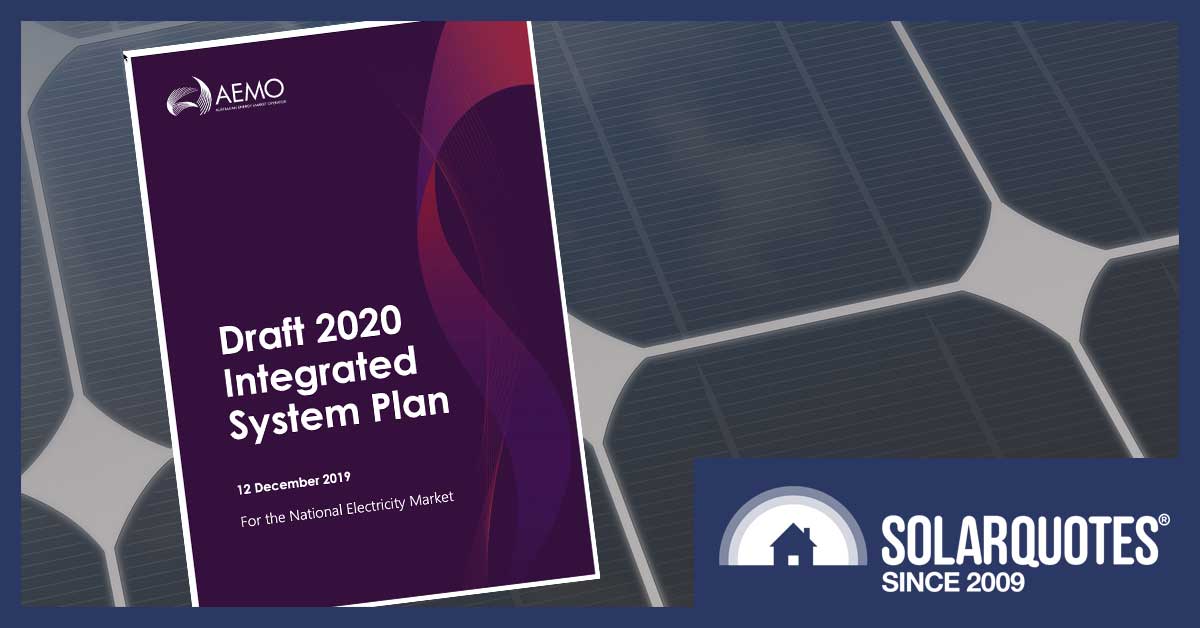
Australia’s Energy Markets Are Broken Because They Ignore Externalities
You would think the middle of a horrendous bushfire season — at a time when large areas of New South Wales were ablaze and air quality in Sydney was worse than Shanghai thanks to smoke hanging in the air like the ghost of gums before drifting out to sea — would be a bad time for the Australia Energy Market Operator (AEMO) to announce they are okay with people dying from fossil fuel use as long as someone is making money from it.
You’d think they’d really do their best to avoid that, but they went and did it anyway in their Draft 2020 Integrated System Plan. All I can say is, thank god it’s a draft report, because they have a chance to take the evil out before it’s final.
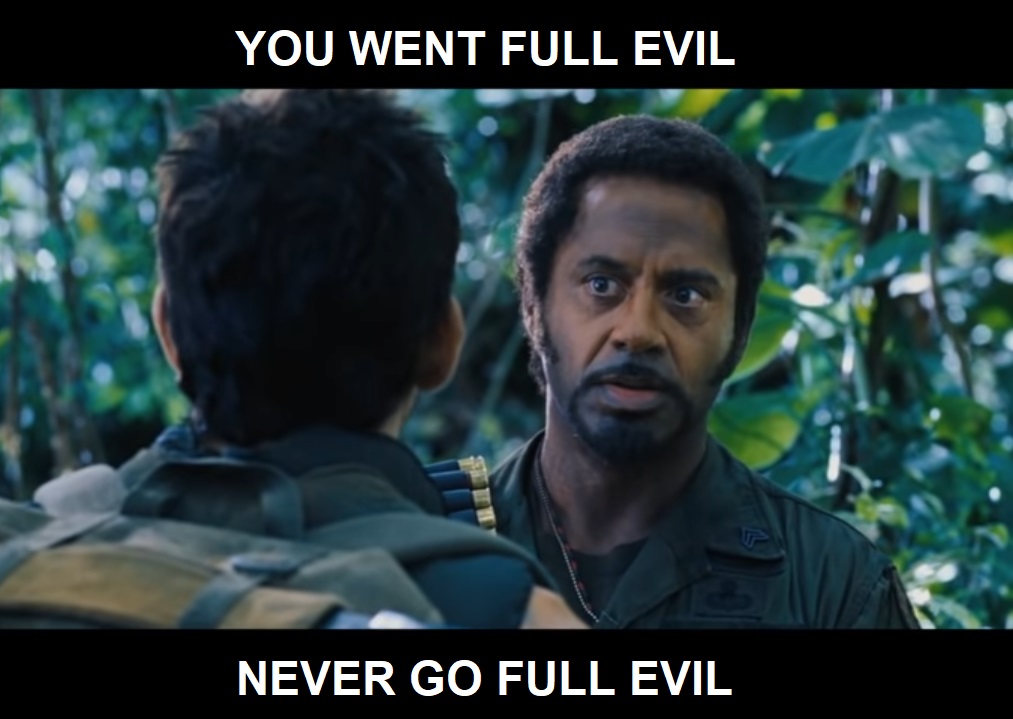
Australian actor, Kirk Lazarus, gives good advice.
The problem is clearly stated in part A of the executive summary of the draft Integrated System Plan (ISP):
For those that don’t spend hours a day thinking about these things or have simply become numb to corporate buzz-speak, you may not see what the problem is. So, for clarity, I’ll underline the evil part and then launch into a protracted explanation/rant on why it’s evil and why the AEMO should be fighting to change the system and not saying they’re okay with people dying as long as the market’s doing well:
Our Energy Markets Are Broken
The problem with “maximising net market benefits”1 is our energy markets are broken. Broken in a way that breaks bodies. This is because they ignore externalities, which are costs society pays but are not included in market prices. This allows fossil fuel power stations to sell the electricity they produce without paying for the harm it causes.
For energy the two main externalities are:
- Health costs from particulates and toxins released into the atmosphere from burning fossil fuels. These can cause sickness, disability, and death.
- Costs of global warming from greenhouse gases emitted by burning fossil fuels.
There are other externalities such as:
- Reduced agricultural production from ground level ozone and other toxins emitted by coal power.
- Water consumption and pollution.
- Increased global warming from coal and diesel soot darkening ice, snow, and other surfaces; causing them to reflect less sunlight energy back into space.
- Increased cleaning costs caused by soot.
But the first two are more than enough to make reducing fossil fuel consumption a much higher priority than Hawaiian holidays or hobnobbing with cricket players.
An Externalities Example
In our current broken system, if there are two companies:
- Company D for dirty, which uses coal and gas to generate electricity, and…
- Company MC for mostly clean, which uses solar, wind, gas, and battery storage.
If these two companies supply identical amounts of electrical energy at identical times, then they will receive exactly the same reward but no punishment for the harm they cause. This is despite the fact emissions from the smokestacks of Company D may have killed 10 people while Company MC’s meager emissions may not have killed anyone.
If you were choosing a roommate you’d obviously go for the one that probably didn’t kill anyone, rather than the one that killed roughly 10 people but insists:
“It was only business.”
If you were instead choosing which electricity generation company you were going to allow to operate in your state, you’d be nuts to allow Company D, as that would be the action of a sadist.
If Company D was already operating in your state and your state was dependent on the electricity it produced then, assuming you’re not a sadist, you’d obviously want them to stop killing people. If immediately shutting down their most polluting capacity wasn’t feasible, then the most economically efficient way to encourage them to clean up their act would be to make them pay for the cost of their externalities.
Being forced to pay for the health and environmental costs of their pollution gives Company D a strong incentive to produce cleaner energy. But if it’s not possible to produce enough clean energy to meet demand, then dirty energy can be produced. It may cost more as they have to pay for externalities, but there’s no need for the lights to go off.
Generators Paying For Externalities Does Not Make Us Poorer
If fossil fuel generators are made to pay for their externalities we don’t end up poorer as a result. This is because it doesn’t increase costs, it only changes who is responsible for them.2
If generators are made to pay for the health costs of burning fossil fuels then, even though they’ll try to pass along as much of that cost as they can in electricity bills, it means less money from other sources, whether government tax revenue or from our own pockets, will be needed to pay for healthcare and days of work and life lost.3
We will be better off than before because once generators have to pay for their health and environmental externalities they will have an incentive to stop polluting so much and build cleaner generating capacity. We will end up better than we were before, both healthier and safer, by making the responsible parties pay for the harm they cause.
The Health Costs Of Coal Are Real
One report that addresses the health costs of coal gives a a figure of $2.6 billion a year.4 This report is from 2009 and in that time we have barely decreased our coal consumption, and as the population has increased there are more people breathing the pollution. Also, we’ve become richer, which means the value of hours of work or leisure lost due to illness or deadness are now higher.
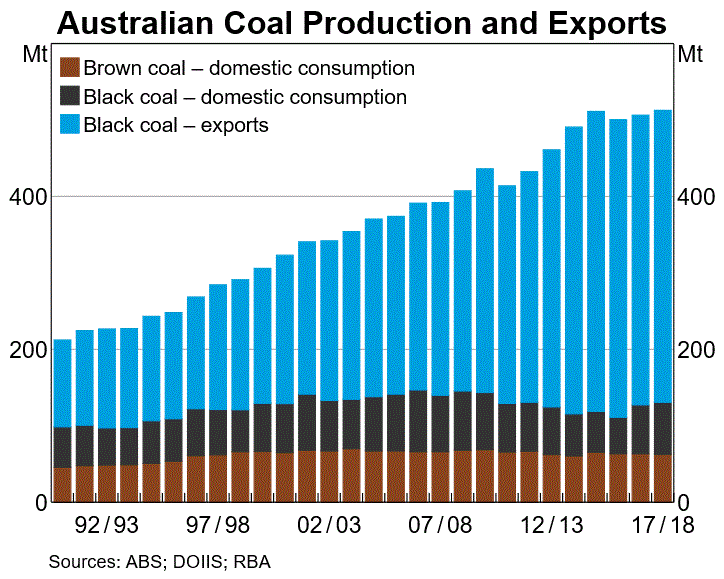
The brown and black bars are Australia’s domestic coal consumption. (Image: Reserve Bank of Australia)
After adjusting for inflation over the past 11 years, the $2.6 billion comes to $3.2 billion in today’s money. If I also adjust for the 16% increase in Australia’s population it comes to around $4 billion per year. With 25.6 million people in Australia, that’s equivalent to $156 per person or $406 for the average household size of 2.6 people. While this cost doesn’t appear on our bills, it is something we’re all paying, although some get off lightly while others pay the ultimate price.
As the average annual residential5 electricity bill is around $1,400 then, according to the $4 billion figure, the hidden health cost means we’re actually paying about 30% more. But instead of it appearing on electricity bills we pay for it through health insurance, the medicare levy, general taxation revenue, and suffering.
As Australia generates around 160 billion kilowatt-hours from coal per year this comes to around comes to around 2.5 cents in health costs per kilowatt-hour of coal electricity.6
Direct Health Costs Similar To Current Environmental Charges
The environmental charges on electricity bills currently come to around 2 cents per kilowatt-hour for grid electricity:
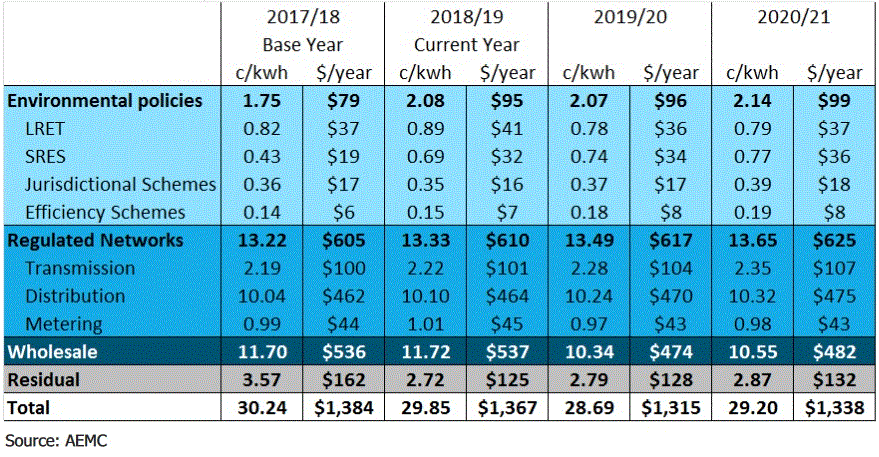
This table was published by the Australian Energy Market Commission in December 2018 so their figures for this financial year and the next are only estimates. As the LRET (Large-scale Renewable Energy Target) is being wound down, its cost is expected to fall a long way over the next few years. (Image Source: AEMC)
If these charges were only applied to coal fired power generation they would come to around 3 cents per coal kilowatt-hour.
I’m not saying the environmental charges mean the health costs of coal are already included in what we pay for electricity. Instead, I’m pointing out that axing these environmental charges won’t make Australians better off, as without them we’d suffer from more externalities thanks to our broken energy markets.
These environmental charges have protected our health by preventing the expansion of coal generation and, when the environmental benefit of avoided greenhouse gas emissions are included, have been well worth it — even though they would have been more effective if they had been direct charges on fossil fuel externalites. But for some reason our politicians didn’t want to do that.
Air Pollution Makes Us Heaps Dumberer
The $4 billion figure is only an estimate of the direct health costs of coal pollution. The are also indirect costs and these appear to be massive. In addition to making us sick and dead, air pollution also makes use dumberer than we otherwise would be. It affects the mental development of children so they don’t grow up as sharp as they could be and we also become temporarily dumber when exposed to air pollution.
Australia is not a clever country. If it were, we would have been smart enough not to try to describe ourselves that way. To me it’s clear we need all the smarts we can get. While it’s not possible to be certain what the total cost of reduced intelligence and other effects of air pollution are, the Lancet puts the cost of air pollution from all sources at 3.52% of GDP for developed countries:
Australia has a $2 trillion GDP so that would come to $70 billion per year. Hopefully, the cost would be less for us thanks to our better than average air quality:
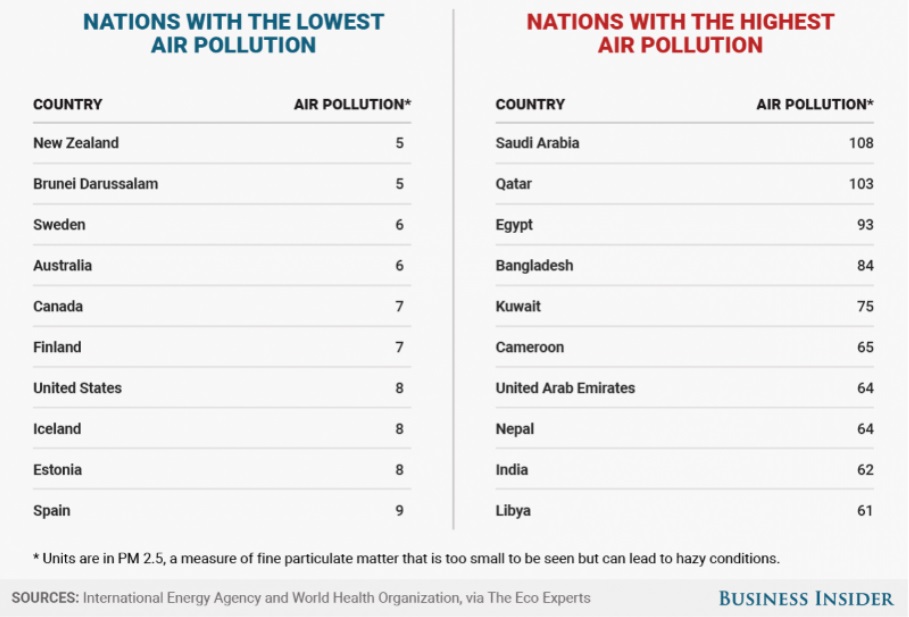
This list is a few years old now and is definitely not based on recent measurements. (Image Source: Business Insider)
In addition to its direct health costs, air pollution is taking a large toll on society by preventing us from reaching our full potential. I don’t know how to calculate the losses from this and the reason may be because I’ve been exposed to too much air pollution.
The Costs Of Greenhouse Gas Emissions Are Real
There are real and serious costs to greenhouse gas emissions destabilizing the climate. You only have to look at the current disastrous bushfire season to see that. Bushfires would still occur if humans hadn’t caused any global warming, but the approximate 1.5 degree increase in Australian temperatures over the past 100 years has extended the bushfire season and increased risk. As I write this, more hectares have been burned than since the start of accurate record keeping and at least 22 people have been killed. There will also be hundreds, or possibly thousands, of excess deaths due to the additional air pollution from smoke.
While we can’t determine exactly how much additional harm the bushfires caused as a result of climate change, we can be confident it was considerable and immediate action to cut emissions is warranted. After all, we don’t wait to calculate the exact chance of an oncoming bus hitting us before we jump out of the way.
Putting A Price On Carbon
Economists have looked at various costs of global warming, including loss of coastal real estate due to rising oceans, decreases in agricultural and labour productivity, the spread of disease, and other factors and have generally concluded we should put a price on carbon dioxide emissions of at least $50 a tonne, with the IMF suggesting $110 a tonne by 2030.
But I have a simpler way of determining what the carbon price should be. We have already increased the amount of CO2 in the atmosphere by 27% in the past 50 years:
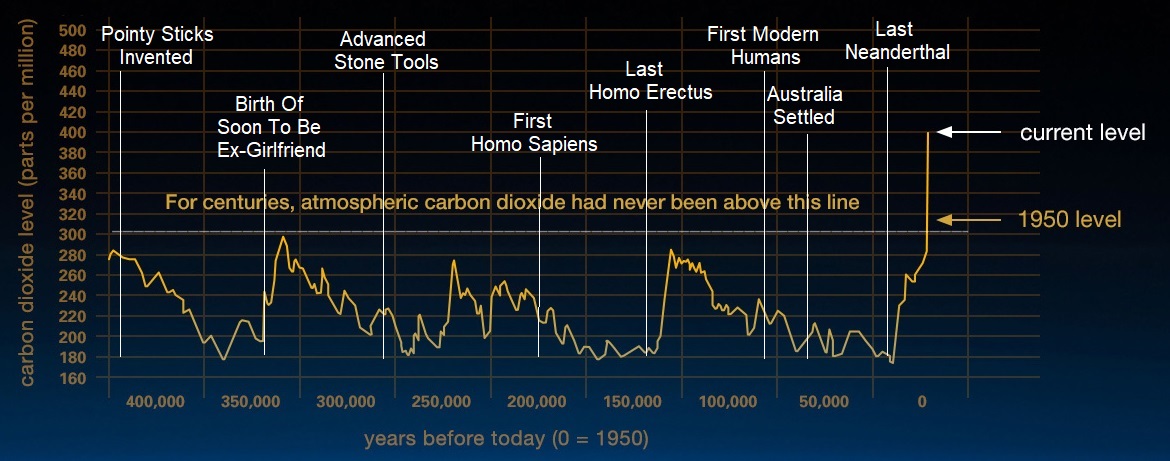
I got tired of CO2 graphs that only show the past 100 or so years, so I found this one that shows how out of whack things are from the point of view of human evolution. (Image Source: NASA — But I added in the notes along the top.)
The amount of additional CO2 or other greenhouse gas that is safe to add to the atmosphere is zero. Because of this, I say the price that should be put on emitting one tonne of CO2 into the atmosphere should be equal to the cost of removing it from the atmosphere and sequestering it long-term.
My estimate of what this may cost is roughly $70 per tonne.7 My Enough Is Enough point of view ends up being lower than the IMF calculations, so I guess I’m just more optimistic than they are. (I’m not sure this means I’ve been exposed to more or less air pollution than they have.)
When CO2 emissions from mining are included, generating one kilowatt-hour of electricity from coal in Australia emits around 1 kilogram of CO2. Using my figure of $70 per tonne of CO2, the carbon price for coal generation should be around 7 cents per kilowatt-hour. If we just consider emissions from generation then natural gas does much better:
- Coal carbon price per kilowatt-hour — 7 cents
- 50% efficient Combined Cycle natural gas, eg. Pelican Point Power Station — 2.5 cents
- 25% efficient natural gas, eg. old gas turbine used in heat wave conditions — 5 cents
Unfortunately, natural gas leaks from extraction, refining, and transport will increase carbon prices for natural gas generation,8 but they should still be significantly better than for coal.
We Need To Fix Our Energy Markets
Just to be clear, saying our energy markets are broken is not a communist thing. Just because I look like the love child of Karl Marx and Friedrich Engels (they had several) does not mean I’m against markets. My attitude towards markets is the same as my attitude towards fire. A very useful tool but a lousy thing to sacrifice your children to.
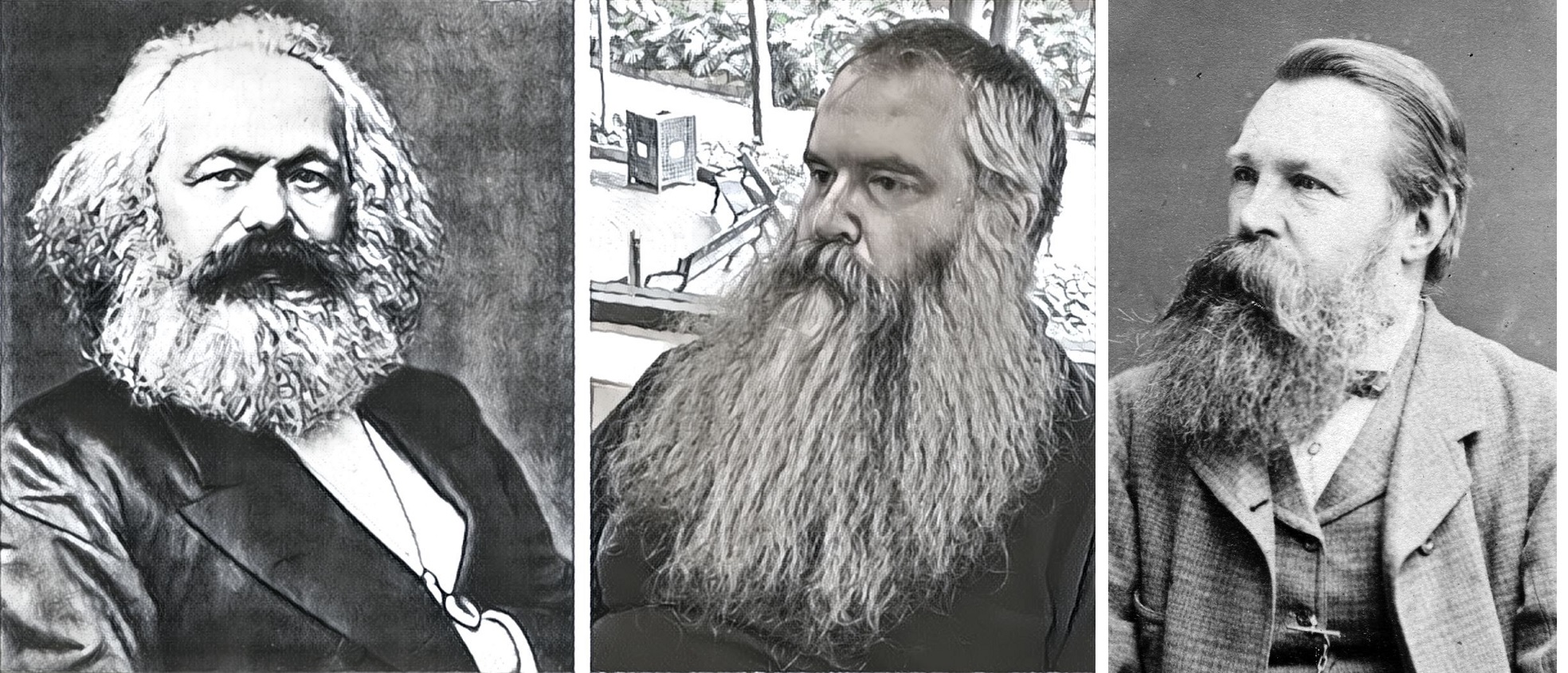
Karl Marks on the left, Friedrich Engels on the right, and Ronald Brax in the centre: “By the power of their beards combined!”
To work efficiently, energy markets need to take externalites into account. I want markets to be efficient and to be a benefit and not a hindrance to humanity, so my stance is pro-market. Because the Coalition removed the carbon price we used to have and refuse to consider pricing in any fossil fuel externalities, their stance is anti-market.
Unfortunately, our energy markets will remain broken until we repair them and we need to start now because the damage caused by climate change will only grow if we delay. We will all suffer the consequences of inaction and we’re dragging our children into this mess along with us. This makes me sad because I have children and I actually like some of them.
A Carbon Price Isn’t Necessary But Action Is
My advice is to put a price on each kilowatt-hour of fossil fuel generation equal to the cost of its health and environmental externalities. This is because it’s the most economically efficient way to transition from dangerous to safe energy. But we don’t have to do that. There are other options. We could use regulation to require fossil fuel generators do one or more of the following:
- Meet a steadily tightening restriction on emissions per kilowatt-hour or face hefty fines.
- Participate in a reverse auction each year to receive money to permanently shut down coal capacity, with the amount paid by the remaining greenhouse gas emitting generators.
- Pay into a climate disaster fund.
- Pay to offset their emissions in various ways.
- Require them to capture and sequester a steadily growing portion of their emissions.
There are also plenty of other things that could be done. Sure, it would be dumb not to make generators directly pay for externalites, but when our grandchildren point out how stupid we were, we can blame it on air pollution.
Normally We Try To Save Lives
If we could instantly replace all fossil fuel generation with clean renewable energy, that would be wonderful. Unfortunately, that’s not going to happen. But just because it’s not practical to halt the burning of fossil fuels over a weekend doesn’t mean we shouldn’t bloody well discourage their use.
Cigarette smoking is a threat to Australian health the government actually gives a damn about. As a result, we have:
- High cigarette taxes
- Horrific packaging showing health consequences
- A ban on advertising
- Funding for anti-smoking programs
Today Australia is a world leader in the struggle against tobacco mortality and morbidity. There’s no reason why we couldn’t eventually earn similar respect in the fields of fighting air pollution and climate change. But by giving fossil fuels a free ride on their externalities, it’s like our government saying cigarettes should be taxed the same as salad, while the AEMO is saying its goal is to help Australians save as much money on cigarettes as possible.
Coalition politicians who downplay the effects of climate change on bushfire risk are working hard to make sure fossil fuel packaging doesn’t scare anyone. As they also actively spruik coal power, there’s definitely no ban on advertising.
I suppose the national Renewable Energy Target is like an anti-smoking program, as it has helped prevent new coal “smokers” from being built. Unfortunately, the Abbot government cut the Large-scale Renewable Energy Target by 20% and the current Federal government is allowing it to phase out with nothing to replace it.
The AEMO Can Fight Or Do Nothing While Australians Die
I see the AEMO as being in a similar position to health officials who, starting in the 70s, could either fight to protect Australians from the health risks of smoking, or follow the easy path of inaction promoted by the tobacco industry and many politicians. While there were those willing to stand by and let existing smokers suffer and die and allow children and teenagers take up an addictive and deadly habit, many chose to fight for our health. They fought to protect children from the dangers of smoking and they succeeded in getting anti-smoking legislation passed.
The AEMO should be no more “maximise net market benefits” in a broken system that ignores dangerous externalities than they should be in favour of allowing tobacco companies to sell tax free cigarettes with pictures of ponies on the packets to school children. While I don’t expect the AEMO to fix the system overnight, I do expect them to fight for a better tomorrow. Their job is not to ignore clear and present dangers to the safety of Australians and the world, any more than it’s the job of state water services to ignore increasingly dangerous levels of arsenic in the water supply, just so long as they make sure it gets piped around efficiently.

Image credit: Emjay Peacock, age 12. He gets $10 per illustration. Soon he’ll be able to afford his own P2 mask.
Footnotes
- It’s easy to assume that “maximising net market benefits” refers big to companies making money, but it actually refers to markets acting efficiently and keeping costs low for consumers. But this is not a good thing if it also robs consumers of what they desire the most — health and safety. ↩
- There are, technically, dead weight losses involved with any sort of taxation or redistribution. But these already exist in our current system and making companies responsible for the costs of their externalities can, technically, reduce these losses. ↩
- Making fossil fuel generators and distributors pay for the cost of externalities can affect the progressiveness of our tax systems and this should be taken into account. It’s a simple task for even part-way competent politicians, so clearly we should all cross our fingers and pray they don’t screw it up. ↩
- Page 49 section 2.6.3. ↩
- While residences only consume roughly half of Australia’s electricity, everyone is a member of a residence, so it does make sense to apply the total health cost to residences. ↩
- There are health costs from burning natural gas, but compared to coal they aren’t significant. ↩
- I hope capturing and sequestering CO2 will turn out to be cheaper than this, but I haven’t seen any realistic estimates that would cost considerably less and can be done on a large scale. I’ve seen estimates for olivine weathering of $15 a tonne, but the people who made those estimates obviously don’t have any experience in the sand industry. ↩
- If 1% of the natural gas leaks instead of burning it, it will increase their carbon prices by around one-third as methane, the main component of natural gas, is a greenhouse gas about 34 times stronger than CO2. ↩




 RSS - Posts
RSS - Posts



Excellent article Ronald, thank you. But it’s not AEMO’s fault. They have to comply with the national electricity objective, which does not recognise carbon or health outcomes. The NEO is embedded in the national electricity law, which can only be changed with the agreement of state and territory governments via the COAG energy council. So it is a political rather than a bureaucratic issue. Concerned citizens need to lobby their energy minister. (I wouldn’t bother with the federal minister, who is the latest in a line of professional liars and climate change deniers to hold this role.)
On one hand the AEMO has to do what they’re told. On the other hand we are entering Eichmann territory. It’s still a draft report and can be changed. Zibelmann doesn’t have to per her name on the report or she can have it changed it before it’s final.
Ronald, you’re completely ignoring the substance of Mark’s reply. There is no “on the other hand”. AEMO must follow the NER and NEO, which constrains the ISP to exactly the document it is today. Zeibelmann has as much power to change the essential nature of the document as you do.
Lobby the AEMC and COAG if you want to change things – blaming AEMO for the structural issues in the electricity market is a waste of your time and energy. Worse, it diverts attention and lets the real bad actors off the hook completely.
As such, 10/10 for passion and motivation, 3/10 for factual content. Could have been an excellent article, but in its current form falls well short of the mark.
Mark is quite correct that people should be complaining to their Energy Minister and not the AEMO as the AEMO does not make policy. However, when I see someone doing something that is going to get people killed, I point it out and recommend they stop doing it without caring who is officially responsible.
Because the AEMO doesn’t make policy they are in a difficult position, but I’ll assume you are Australian and I don’t need to explain the difference between “not being allowed to do anything” and “not doing anything”. No doubt many of us have worked for large organizations and have been faced with a decision between doing what you were told and doing what was moral. Some of us regret decisions we made under those circumstances.
As for giving only 3/10 for factual content, most of the of the article is an explanation of externalities and market failure to help equip people to make their own decisions. If I only deserve 3/10 for that then I have a lot of article updating to do.
I’d say your facts are better than that, closer to 9/10 from what I understand. I’m sure there’s something I’m missing, but you’ve got the crux of it right – the market doesn’t work unless all factors are taken into account, in this case the externalities of health and climate damage.
A couple of observations:
This season’s pan-Australian fires have already exceeded 2/3 of the country’s total greenhouse emissions budget, according to one report. That doesn’t leave much for fossil fuel burning, if we’re to meet our commitments “at a canter”.
The greenhouse credits from privately held forests were seized without compensation some years ago, and used to meet Kyoto promises. Not only have those credits been cashed in to our debit by these fires, but the loony delusion that forests sequester carbon on an overheated dessicated planet is now completely discredited. We must find real ways to meet our obligations – and provide a viable future for our children.
Incidentally, carbon capture and storage is a fraud. There aren’t enough compatible rock structures for the gigatonnes of CO2 produced annually, and at the 5.1 atmospheres (520 kPa) minimum pressure for liquefaction, it will find its way back to the surface, as “economic” rather than dwindling numbers of entirely secure sites are used. All that is needed in reality is coal sequestration by leaving it in the ground, then the problem is much more cheaply and securely solved. (Pumping gigatonnes of CO2 underground is in reality Oxygen Sequestration, as the carbon was down there to begin with, so no net gain there.)
With the current government’s Carbon Capture story is the (next) lie of convenience it has needed to drift to because the previous lies attempting to discredit the science has blown up in its face.
Carbon Capture works NOWHERE on the planet but the right wing media peddles it as fact when it is fiction intended to stave off the inevitable.
AEMO is the “operator”. Why isn’t your paper directed at AEMC? AEMO actually do a good job given the hand they are delt.
AEMO is full of smart, capable people who understand the existential threat of global heating. They need to stand up and point out that the hand they have been dealt is morally reprehensible. Not just keep oiling the machine. Everyone needs to stand up.
And how long do you think Zibelman would last if they suddenly became climate change crusaders? She has actually changed the culture at AEMO considerably. The very fact that they are modelling a step change scenario is evidence of that. Give them some credit. You are being quite naive.
I get called that a lot. I prefer to be called unreasonable (being a fan of George Bernard Shaw).
After reading the article, and the comments that followed. I am still somewhat heartened. My deepest concern is that whilst solarquotes seems to be a fantastic resource that is due substantial credit, moreso it encourages those “with a brain, and valued opinion” to share their views. I implore those responders (myself included) to take motivation from Ronald’s article (and many other informative articles regularly posted) and “do something” with your opinion and deemed knowledge. Lobby, email those we voted into power, join a community activist group that will action change!! If we just talk about what should be done and do not attempt to “action change” ourselves- then we are to blame!
Thanks Ronald for igniting the passion in all of us (pun intended). My sincere regards to those that are and may be affected by our current and very “visual” climate emergency. Let the momentum build. Ranald
Come on guys. You all need to step back and look WHO is driving this debate. It shouldn’t be too difficulty to see the current government up to its eyeballs in this BS.
When one recognises that the coal industry via electoral donations (bribes!) controls the game the rest becomes much clearer. All other public organisations then sing the same tune lest the top brass in these organisations lose their very cushy jobs. The public service and government owned infrastructure organisations are not removed from their master.
Listen to the BS which keeps coming from our right wing governments. It s clue to what echoes down the line. Please not that both the NSW Premier AND the Prime Minister refused to talk about climate change. When the fires are done they’ll repeat this claiming they’re ‘getting on with the job’.
Thanks for reporting the spot fire Ronald but the firestorm is where you needed to be mate.
Ron
you have been very selective on the facts and perspective is this article as all seem to be these days – writers privilige I guess
can you please add another line to your CO2 graph to the same scale showing the global temperature change so we can clearly see the association between the CO2 and temperature
thanks
Peter, approximately 90% (if memory serves) of global heating goes into the oceans, and thermal mixing from the heated atmosphere varies from month to month with wind and wave activity. But the residual 10% is steadily cranking surface temperature upward.
Even though it underestimates the massive amounts of heat absorbed, we usually take the more visible land temperature as the metric. The latest figures I’ve seen are 0.85 deg. C for Europe and 1.14 deg. C for Australia. Presumably it’s the latter single figure you want? There’s a warming bar chart for Australia, from 1910 to the present toward the end of this informative fire & climate BBC page: https://www.bbc.com/news/world-australia-50951043
You’ll have to admit that the median line is following rising CO2 without any sign of varying the trend, beyond getting a little steeper lately.
Granted, the Indian Ocean Dipole is a big factor in reduced rainfall, but the crook IOD is due to heating of the western Indian Ocean – and guess what’s causing that?
If there is anything in the article that is wrong, let me know and I will update it.
I’m afraid you over estimate my graphic making ability. I can deface one produced by NASA easily enough, but I seriously could not be arsed to put in CO2 data for the past 400,000 years. That’s going back, like, three interglacials before this one. Just let me check that… Holocene, Eemian, La Bouchet, and Purfleet… yep, four in total. But if you can find a link to a graph that shows it, feel free to post it so people who are interested can have a look.
But if you just want a graph over the past 140 years of temperature and CO2 that’s easy enough to provide. There’s one at the top of this page:
https://www.climate.gov/news-features/climate-qa/if-carbon-dioxide-hits-new-high-every-year-why-isn%E2%80%99t-every-year-hotter-last
Ronald Brakels,
Another excellent piece, Ronald!
For anyone that may be interested:
1. The Engineers Australia YouTube video (see link below), from time interval 0:29:15 through to 0:23:00, includes IMO an excellent animation of atmospheric CO2 content through the ages. The animation begins with a graph of actual CO2 readings from multiple measuring stations around the globe from Jan 1979, month by month, through to Jan 2011. Then the Keeling data measurements are added looking backwards from 1979 through to 1958, followed by the ice core proxy data going back to 800,000 years BCE (before current era).
See: [Engineers Australia Big Conversation] https://www.youtube.com/watch?v=CNT1XjBAxRE
See also: [The Keeling Curve Hits 415 PPM] https://www.youtube.com/watch?v=Z43FQCSg4Ow
2. Another YouTube video (see link below), includes a of part of Professor Schellnhuber’s address, from time interval 0:15:35 through to 0:18:24, that includes an animation of how estimated cumulative human-induced CO2 emissions on Earth at specific locations (and globally) have risen from year-1750 through to present (2018), then projecting out to year-2100 (based on current GHG emission trajectory). Then from 0:18:24 through to 0:22:12, Schellnhuber explains why there have been ice ages in the past, ten in total over the last 800,000 years, and why there won’t be any more ice ages ever again through to at least the 100,000-year horizon – accumulated human-induced GHG emissions are now so extensive that it has overridden the Earth’s natural climate state. A graph showing the critical insolation–CO2 relation function curve (a function of the Sun’s insolation and Earth’s spin axis tilt variation and procession/wobble, and orbital perturbation characteristics) overlaid with an actual/proxy atmospheric CO2 concentration curve, plus indicated past glacial inception periods, from 800,000 years BCE to present, is IMO also well worth a look.
See: [Keynote Debate Can the Climate Emergency Action Plan lead to Collective Action? (50 Years CoR)] https://www.youtube.com/watch?v=QK2XLeGmHtE
https://climate.nasa.gov/evidence/
No argument here guys. Only with a coal owned government which betrays us all for its fistful of electoral donations.
Be careful who you vote for…….as many who lost their homes recently need to think about.
Climate change is no longer the subject of discussion and those who seek to have an endless talk fest are just lying to us all to avoid doing what needs to be done: closing down the coal industry!!!
Sorry about the soap box. I feel strongly about an inhabitable world for my grandchildren.
Higher levels of CO2 in the atmosphere are not all bad. Photosynthesis is the process where plants take CO2 and sunlight to make plants grow. The higher CO2 levels in recent years have increased the yield of plants…
EDIT: Hi Steven, Ronald here. Could I just get you to point out a few drawbacks of global warming for food production before you move onto anything else? Otherwise people might come away with too positive a picture of the effects of increasing greenhouse gases.
Quite so Ronald.
More heat, failing crops due to rainfall concentrating in other parts of the planet, floods which help nobody, rising sea levels which will in time displace billions of people let alone the cost of rebuilding elsewhere and the greenhouse gases generated in this disaster and finally the ceasing of the ocean currents which produce the weather cycles we have.
More CO2 sounds a lot like the fossil fuel industry chant to con people into believing burning coal is a good thing.
I liked the article.
My take-out is that if we apply a “triple bottom line” (that’s my analogy) approach to electricity generation and distribution costs, then we can see the true “personal and global” costs of fossil fuel fired electricity systems compared to renewables.
So, I encourage agencies and individuals to put these facts/arguments to our law makers.
There may be dispute over who is to blame for this, but that is trite.
The earth is warming.
The climate is changing.
The oceans are warming.
The industrialisation of the world since that late 1800’s has caused these changes.
We are all perpetuating them by using oil, coal and gas products and by-products.
It seems clear that we have to break this vicious cycle if we are going to maintain “life-on-earth” as we would like it to be.
So, seeing AEMO taking some timid steps to address these issues, does rankle.
Particularly when Zeibelman has a lot of political capital to spend.
Thanks for the thought provoking article.
” You would think the middle of a horrendous bushfire season — at a time when large areas of New South Wales were ablaze and air quality in Sydney was worse than Shanghai thanks to smoke hanging in the air like the ghost of gums before drifting out to sea — would be a bad time for the Australia Energy Market Operator (AEMO) to announce they are okay with people dying from fossil fuel use as long as someone is making money from it. ”
Cheap sensationalism, poor journalism. The bushfires are unrelated to electricity production, and to try to conflate deaths from bushfires with energy policy does nothing for your credibility, sir.
Hello OldCynic. Burning fossil fuels releases greenhouse gases. These greenhouse gases contribute to global warming and raise temperatures. Higher temperatures increase bushfire risks, resulting in more bushfire deaths than would otherwise occur. If you need evidence I can provide links. We’re all in this together and things will get worse unless enough of us understand these facts and act on them. Getting in the way of change will contribute to more unnecessary deaths.
Ronald, trying to open the eyes of slow learners is a thankless task. And while our great leader is the ultimate SloMo, the task is steeply uphill.
The tragedy is that there isn’t time any more for climate recalcitrance – the fires have already exceeded 2/3 of Australia’s emissions budget, so will more than double our total national emissions by the time they’re extinguished.
So not only are we doubling our emissions at a canter, but this insanely rapid climate feedback effect accelerates the rate of global heating, helping to bring 2 deg. C global heating not at a canter, but at a gallop. (Climate inaction is still a global malaise.)
And 1 deg. C has increased glacial ice-melt by a factor of 7. Will it only be 49 times faster than before as we gallop to 2 deg. heating? Current global inaction has us on a course for 3.9 deg. C global heating. There will be action before then – of eventual benefit to the survivors. But if we stopped burning fossil fuels by 5 p.m. today, the inescapable 0.5 deg. C global thermal lag guarantees we will hit 1.5 deg. C heating.
IF we can break the coal and oil addiction within another 0.5 deg. C of global heating, then we’ll still hit 2 deg. C. I do not expect Australia to be able to feed itself in that climate, without major measures to manage water and fire. (Environmental flows or food for your children – please choose.)
Well Ronald, you have stirred up a hornets nest of coal fuel aficionados!!
They all say similar things. They may as well all have the same name.
Given the amount of them, you might want to set up a special inbox for them.
Call it More-Rons.